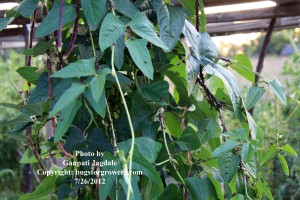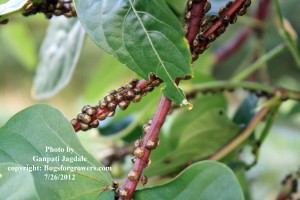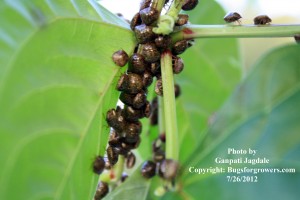Incidence of Kudzu bugs on Chinese long beans
For the last couple of years, I have been growing Chinese long beans (Vigna unguiculata subsp. sesquipedalis) in my organic garden. Although this year (2012) I did not plant these beans in my garden, but noticed that early in the spring few number of Chinese long bean seeds were germinated voluntarily.
This means bean seeds from last year’s crop were overwintered in the soil and germinated early in the spring because there was enough moisture in the ground and optimum temperature for their germination. So I let these voluntarily germinated vines/plants to grow in my organic garden.
Over the growing season, these plants grew very well and healthy without the infestation of any insect pests. For the last few weeks these plants are producing a lot of pods that we have been harvesting at their maturity and shelling from them beans (grains) and preparing delicious curries.
However, two weeks ago, I noticed that the vines of my Chinese long beans were heavily infested with Kudzu bug, Megacopta cribraria (Fig. 1).

Last year, I did not see any infestation of Kudzu bugs on beans but as shown in pictures, they are now feeding on the pods (Fig. 2), leaves and stem (Fig. 3) of Chinese long beans.


The immature and mature stages of Kudzu bugs are dark brown (Fig. 2) and greenish brown (Fig. 3) in color, respectively. Both mature and immature stages of Kudzu bugs feed on the long bean vine/plant. Since these Kudzu bugs have sucking type of mouthparts, they suck cell sap from leaves, stem and pods. The intensive feeding by these bugs can cause leaves, stem and pods to dry and eventually cause the death of vines/plants.
Possible organic control measures
- Although I don’t know how to control these Kudzu bugs organically, I have decided to spray garlic extract (prepared by grinding garlic in water) as a repellent. I will let you know the effects of garlic extract on the Kudzu bugs in my next blog.
- Meanwhile, I have also exposed both nymphs and adults of Kudzu bugs to entomopathogenic Steinernema carpocapsae nematodes in a petri dish. I will also communicate with you the results of this experiment in my next blog.
